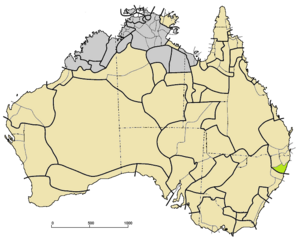Gumbaynggiric languages facts for kids
Quick facts for kids Gumbaynggiric |
|
|---|---|
| Geographic distribution: |
New South Wales |
| Linguistic classification: | Pama–Nyungan
|
| Subdivisions: | |
 Gumbaynggiric languages (green) among other Pama–Nyungan (tan)
|
|
Gumbaynggiric refers to a group of two closely related Australian Aboriginal languages: Kumbainggar and Yaygir. These languages are part of the rich history and culture of the Aboriginal people of Australia. They are spoken in specific areas of New South Wales, on the east coast of Australia.
Contents
What are Gumbaynggiric Languages?
The Gumbaynggiric languages are a small family within the much larger Pama–Nyungan language family. Think of a language family like your own family tree, where different languages are related to each other because they came from a common ancestor language long ago. Kumbainggar and Yaygir are like cousins in this language family.
These languages are important because they carry the stories, traditions, and knowledge of the Gumbaynggirr and Yaygir peoples. Learning about them helps us understand the amazing diversity of human languages and cultures around the world.
Where are These Languages Spoken?
The Gumbaynggiric languages are traditionally spoken in the coastal and hinterland regions of northern New South Wales, Australia. This area stretches along the coast, including places like Coffs Harbour and Maclean.
The map shows the traditional lands where these languages were spoken. The green areas on the map highlight the regions where Gumbaynggiric languages were used, surrounded by other Aboriginal language groups.
Kumbainggar and Yaygir: Two Special Languages
While Kumbainggar and Yaygir are related, they have their own unique features. Both languages have faced challenges over time, but there are now efforts to bring them back and teach them to new generations.
Kumbainggar Language
Kumbainggar is the more widely known of the two Gumbaynggiric languages. It was traditionally spoken by the Gumbaynggirr people, whose country extends from the Nambucca River in the south to the Clarence River in the north, and west to the Great Dividing Range.
Like many Aboriginal languages, Kumbainggar has a complex grammar and a unique way of describing the world. It includes many words for local plants, animals, and landscapes, showing the deep connection the Gumbaynggirr people have with their land.
Yaygir Language
Yaygir, sometimes spelled Yegir, was traditionally spoken by the Yaygir people. Their country is located around the mouth of the Clarence River and along the coast near Maclean.
Less is known about Yaygir compared to Kumbainggar, as fewer speakers remained in recent times. However, linguists and community members are working to record and revitalize what is known about the language, often using historical records and the memories of elders.
Why are Indigenous Languages Important?
Indigenous languages like Kumbainggar and Yaygir are much more than just words. They are vital parts of cultural identity. They hold:
- History: Stories passed down through generations.
- Knowledge: Information about the land, plants, and animals.
- Culture: Songs, ceremonies, and traditions.
When a language is lost, a huge amount of cultural knowledge can be lost with it. That's why efforts to preserve and revive these languages are so important.
Keeping Gumbaynggiric Languages Alive
In recent years, there has been a strong movement to revitalize Aboriginal languages in Australia, including Kumbainggar. Community groups, schools, and universities are working together to:
- Teach the language: Classes are held for children and adults.
- Create resources: Dictionaries, grammar guides, and learning apps are being developed.
- Use the language: Encouraging people to speak Kumbainggar in everyday life.
These efforts help ensure that the unique sounds and meanings of Gumbaynggiric languages continue to be heard and understood by future generations.
See also
 In Spanish: Lenguas gumbaynggíricas para niños
In Spanish: Lenguas gumbaynggíricas para niños

